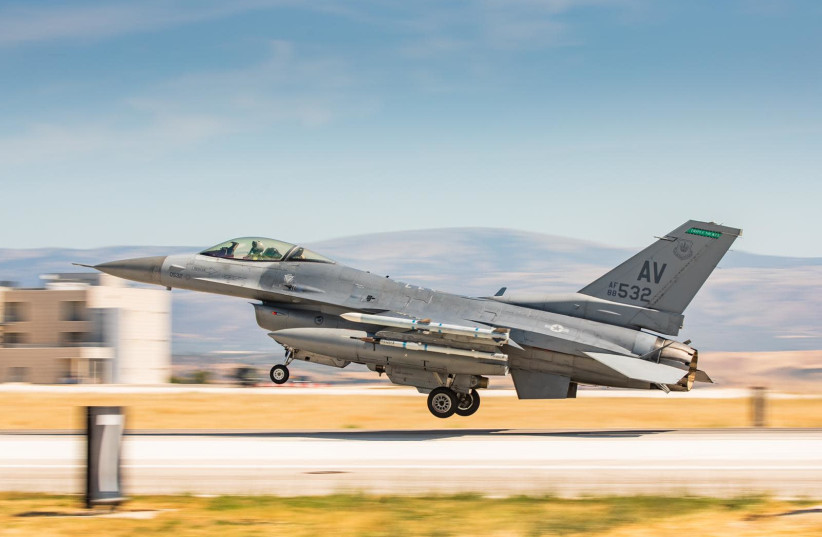Syrian and Russian military jets patrolled together near Syria’s border with Israel on Monday. The report comes as tensions in Ukraine are at a boiling point, with Western powers accusing Russia of plotting an invasion.
Russian joint patrols with Syria could become a regular event, Russia has indicated. The reports have come from Russia’s Defense Ministry and Interfax, an independent Russian news agency. This has ramifications for Israel and could impact its operations that target Iranian weapons transfers to Hezbollah.
Israel has conducted a “campaign between the wars” that is used to prevent Iran from entrenching in Syria and moving weapons to Hezbollah. The IDF says this is the term for the “IDF’s prevention and influence approach for force employment short of war.”
Much of this campaign is waged in the shadows, but former IDF chief of staff Gadi Eisenkot in 2019 told The New York Times Israel had struck thousands of targets in Syria.
In 2017, IAF commander Amir Eshel said: “When Israel has a vested interest, it acts irrespective of the risks.” Eshel is now director-general of the Defense Ministry.

The big question now is whether the air patrols Russia is embarking on are merely symbolic and will occur during the day as a show of force, or whether they are designed to actually send a message and potentially interfere with Israel’s actions.
It is known that the Trump administration supported Israel’s actions in Syria. However, US officials also were concerned that Iran and its proxies in Iraq and Syria might attack US forces in retaliation for Israel’s actions. In fact, in 2018, Iranian factions in Iraq began to accuse Washington of working with Jerusalem and also began to hint that Iraqi-based militias could target the Jewish state.
In 2021, Iranians attacked the US Tanf garrison in Syria, and US media outlets said the Iranians had acted in retaliation for Israeli strikes. In 2019, Iraqi militias also accused Israel of a series of airstrikes.
Last May, Iran flew a drone from Iraq into Israeli airspace. Meanwhile, the Islamic Republic built up a base called Imam Ali near Albukamal in Syria and moved drones to the T-4 base, also in Syria. Tehran sought to bring the 3rd Khordad air-defense system to the T-4 base in April 2018.
This is the context of the campaign between the wars. The other context is that in the summer of 2018, the Syrian regime retook areas in southern Syria from Syrian rebels and established itself on the Golan Heights border. Russian peacekeepers came as well, and Hezbollah began to entrench near the Golan. This resulted in the terrorist group moving drones toward an area in the Golan in 2019.
Meanwhile, Russia was more focused on reconciling with Syrian rebels and recruiting them for the Syrian army. Moscow began to express more concerns about Israeli airstrikes, going as far as to claim in November 2019 that Israel had overflown Jordan to conduct airstrikes in Syria. It also said it would upgrade Syrian air defenses after a 2018 incident near Latakia in which Syrian air defense shot down a Russian plane while trying to stop Israeli airstrikes.
Moscow also released more statements critiquing Israeli strikes, but it has been quiet in recent months, even after airstrikes in Latakia in December. Prime Minister Naftali Bennett met with Russian President Vladimir Putin last October.
SO WHAT is going on? Russia’s Defense Ministry has clearly indicated that the recent daytime patrol included an area near the Golan Heights. It said the patrol flights “will continue to operate on a regular basis,” Reuters reported.
“The mission route included the Golan Heights, the southern border of Syria, the Euphrates River and northern Syria,” the statement said. “The Russian pilots took off from Khmeimim Air Base, while the Syrians took off from the Sayqal and Al-Dumayur bases near Damascus.”
The patrols included the Sukhoi Su-34 attack aircraft, Sukhoi Su-35S multi-mission fighter jets, A-50 command-and-control aircraft and the Syrian army’s MiG-23 and MiG-29 aircraft, Reuters reported.
While Israel has not been involved in aerial combat in Syria, most of these aircraft are not a match for the IAF’s F-35s and advanced munitions. Israel shot down a Syrian Sukhoi fighter jet near the Golan in 2018; Syria has not retaliated for that incident. Israel has often coordinated with Russia in a kind of deconfliction in Syria since 2015, when Russia began major operations there.
The news of the Russian patrols appears to be a message about showing off that the Syrians and Russians will work closely to project power and impress upon the world that Syria has sovereignty over parts of the country, even though the US has bases there, and Turkey occupies part of northern Syria.
Moscow and Damascus want to send a message of strength to former Syrian rebels in southern Syria who work with Russia. The message may not be directed at Israel or not solely at Israel.
Most reports of Israeli airstrikes in Syria occur at night. There is no evidence that Russian and Syrian warplanes will be patrolling at night.
Four other factors are involved:
- The US has supported Israel’s actions in Syria
- Russia doesn’t always share interests with Iran
- Israel has been reported by the Russians to overfly Jordan to conduct strikes
- Israel can use standoff munitions with a long range, meaning the joint patrols may not yet pose a major problem.
Deconfliction also means potentially making sure the patrols occur with Israel’s knowledge. Israel’s advanced radar can also detect them.
The major question mark is whether these patrols will embolden Syria’s regime and Iranian-backed elements in Syria. Iran could use them as cover to attack Israel or use its proxies to strike at the US and Israel.
This could be one part of a multistage Russian operation to assert Syrian regime sovereignty. Eventually, that could lead to potential friction. Israel’s leadership will have to weigh these issues and analyze its next steps.
